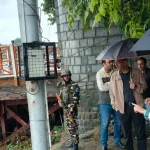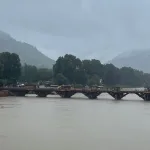Built around 1200 years ago and surviving successive demolitions, the Martand Sun Temple, also known as Martand Shetra, located in the Anantnag district of Kashmir exhibits a marvelous architectural grandeur which dates back to centuries gone by. The monument stands as an epitome of architectural milestone even in contemporary times.
The temple embodies immense significance dating back to the prehistoric era. The experts say that Martand is not confined to temples only as it manifests place consciousness and profound aesthetics. It has ecological and religious significance.
Apart from the religious place consciousness, it houses flora and fauna which have been equally captivating the visitors.
The historians and experts reveal that the Martand temple has immense religious significance. Known as Martand Shetra, this architectural marvel finds mention in the ancient Bringesh Samhita, a manual of religious places in Kashmir that meticulously details all the tirthas, or pilgrimage sites.
The Martand Temple holds a spiritual connect, with its roots extending to the belief that sunlight possesses curative properties for various ailments. Martand was revered as a destination where people sought solace and healing for specific diseases, drawing pilgrims from far and wide.
Martand Temple stands as a living testament to an ancient, significant, and rich history that has weathered the ages. However, its journey through time includes a chapter of demolition during the rule of Mir Sultan Sikandar Butshikan in the 15th century.
Historians and archaeological experts, delving into the intricate layers of Martand’s past, reveal that the temple’s existence predates the tumultuous events that unfolded during the 15th century. Originally standing in a different form, Martand underwent a transformation when it was extended and meticulously rebuilt by King Lalitaditya of the Karkota dynasty.
Talking to Rising Kashmir, Dr Mahesh Kaul said, “Martand was destroyed multiple times and its successive survivals were documented by historians of Kashmir. King Lalitaditya Mukhtapida had made value additions to its aesthetics. There are five Rajtarangini’s written on Kashmir, Juon Raja is the second historian after Kalhana to write the Rajtarangini wherein he has documented the destructions and political upheavels in Kashmir upto the Sultan Zain ul Abidin time.”
Though the Archeological Survey of India commands the task of restoration and preservation of the temple yet the experts decry the callous attitude of the successive govt’s towards failing to conserve the Sanskrit cultural heritage of Kashmir valley.
“Martand is Surya Shetra and was given a face lift by king Lalitaditya who was known as Alexander of India. Martand is the cultural heritage of Kashmir, in fact it should come under one of the leading world heritage sites. Not much has been done for its restoration even though the archaeology department has put up a signboard near its entrance, it needs sustainable development. If its grandeur was restored it could have earned great revenue for us as it possesses immense potential to attract tourists,” Dr Kaul said.
He said that this comprehensive religious structure required proper mapping to conserve it. However it should not be intervened until technical expertise is involved in its process of restoration.
“I reckon a replica of the temple should be created while the original structure should not be touched so that people would experience the architectural marvel it engrosses. We need to recreate it first and then reconstruct it for niche tourism initially.” Dr Mahesh Kaul said.
Adding, “We are culturally insensitive people, we ruin our own assets, people desecrate the precious monuments and destroy their aesthetics.”
Dr Kaul said that there was a need to implement a proper cultural heritage policy. He said once heritage policy becomes credo we could move further in preserving architectural assets.
“We have failed to pass our rich cultural heritage to our younger generations. Nothing of such has been included in the curriculum. We never take students to such sites , there are no documentaries made on these monuments. No efforts have been put together to give it a fillip”, he said.
Speaking with Rising Kashmir, Dr Virender Bangroo, Associate Professor and IGNCA Regional Director Goa said that Martand is an archaeological monument.
Dr. Virender Bangroo stresses the urgent need for concrete efforts to restore the Martand Sun Temple’s glory. He highlights the monument’s significance in the field of architecture and calls for literature and discussions to raise awareness.
“Martand is a milestone in the field of architecture. It is a marvel of stone architecture. We can give elevations to it. I have been studying this monument for the past 30 years . This is the heritage of mankind and we must take care of such monuments. There is a need to discuss all of these monuments and draw literature on them”, he said.
“ The existence of Martand spans meticulous science and technology involved in its construction. Apart from the faith people behold regarding this temple, there is science behind it. We should feel proud of it, this is our achievement. Our children must benefit from it. It is not only about a particular faith it is a beautiful art form which people should appreciate. “, Dr Bangroo expressed.
“Though Archaeological Survey of India ( ASI) is restoring it. They have made some efforts like maintaining the garden and the area. The first and foremost thing is that they have to consolidate the structure. Lots of pillars are broken and missing also. They can create some pillars to give it a grandeur. There is a dire need to cover the centre sanctum with an appropriate rooftop. Due to snowfall expansion and contraction occurs causing cracks and to avoid that shingle roofs could be used.” Dr Virendra Bangroo said.
“We could create the same grandeur. Creating a stone roof would be tremendous but that would be herculean task. To give it a grandeur, first of all we need to conserve it, conservation is the priority for everything”, Dr Bangroo said.
Dr Bangroo said the Department needs to give it a thought that the main sanctum needs to be covered, roofing can be provided which is very important. “We need to take care of all treasured archaeological sites also. In the case of Martand Temple there is no orientation except a signboard; however there has to be an orientation, right at the entrance of this monument,” he said.





